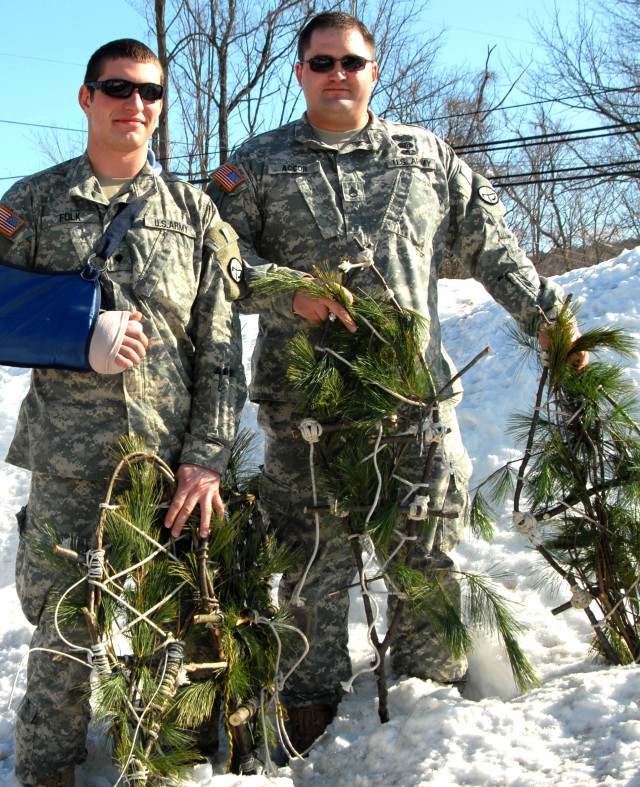
BERKELEY SPRINGS, W.Va. (Feb. 16, 2010) -- Necessity has often been called the mother of invention.
Just ask two West Virginia National Guard Soldiers who found themselves attempting to rescue a mother and her four-week-old premature baby stranded at their home in Morgan County.
The mother and her baby became isolated thanks to back-to-back blizzards that socked the region with more than three feet of snow in some areas.
To reach the pair in the early morning hours of Feb. 10, Staff Sgt. Harry F. Accor III and Spc. Derek C. Folk, two medics with the 201st Field Artillery Battalion based in Fairmont, W.Va., fashioned two pairs of snowshoes from pine tree branches and clothes lines.
What makes the feat perhaps even more amazing is that Folk performed the rescue with three bones broken in his right hand. He sustained the injury earlier in the week while helping to evacuate a bi-lateral amputee with diabetes from his home here.
Both Soldiers were innovative in their efforts to rescue the trapped mother and baby, said Maj. Chris Nasser, assigned from the West Virginia Air National Guard's 167th Airlift Wing as a military liaison officer at the Morgan County emergency services complex.
"They made their own handmade snowshoes to evacuate them," Nasser said. "They were really prepared for whatever they faced."
A concerned neighbor alerted officials to help the mother and baby who were living in an area that had been without power for two days, Accor said.
Because the snow was so deep - up to eight-foot snow drifts in some places - the Soldiers were forced to hike about three miles up a ridge to the home. The only way they could maneuver though the snow without sinking was on the snowshoes.
Getting the mother and baby back down the ridge to a waiting Humvee was just as tricky.
"The child was already wrapped," Accor recalled. Both men said they never stopped to learn the woman's name or even the sex of the baby as they were on a mission.
"We just wanted to get them out of there to safety," Accor said, noting after he got hold of the baby, he wrapped it in more blankets and tucked it into his rucksack. After the baby was nestled in the bag, he placed heated hand warmers around the blankets to keep it warm.
The woman was placed on a 6 feet by 3 feet sked, known as an emergency medical extraction device. Folk said he acted as a sled dog by putting the sked's rope around his waist and pulling it to the waiting Humvee down the ridge.
"The whole time I was walking through the snow I was happy that the snowshoes didn't break," Accor said. As the Soldiers made their way back down the ridge, Folk would look in on the baby who was snuggled in the rucksack on Accor's back.
Once back at the Humvee, the Soldiers transported the mother and baby to a nearby relative's home. "They made arrangements to go to another state to be with family members," Accor said.
Sgt. 1st Class David Hoffman, a fellow member of the 201st Field Artillery Battalion who lives in Falling Waters, W.Va., praised his comrades for their successful rescue effort. "They did a really great job," Hoffman said.
"It's our job," Accor said. "That's what we are here for."
And what about the now famous snowshoes'
Both pairs are expected to be put on display in the battalion's headquarters ... after the two Soldiers are finished using them.
(Army Staff Sgt. Sherree Grebenstein is assigned to the West Virginia National Guard.)

Social Sharing